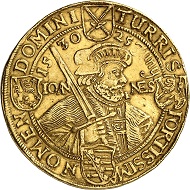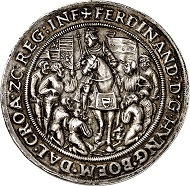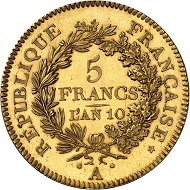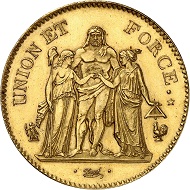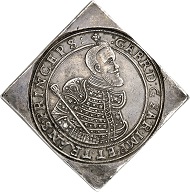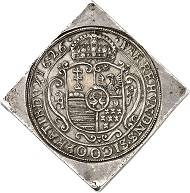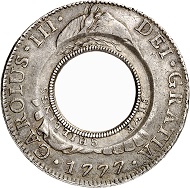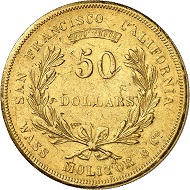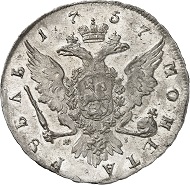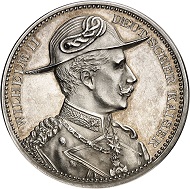03-02-2016 – 01-01-1970
Auction 271
Künker in Berlin: More than a quarter million euros for a Holey Dollar and its dump
Altogether there were only 912 lots which were auctioned off on February 4th, 2016 during the World Money Fair. But these 912 lots sold for an impressive 6.6 million when they were originally estimated at 4.8 million.
No. 291: GERMANY / SAXONY. Johann Georg I, 1615-1656. 10 ducats 1630, Dresden, on the centenary of the Augsburg Confession. Struck from the reichstaler dies. Very rare. Almost extremely fine. Estimate: 12,500,- euros. Hammer price: 44,000,- euros.
There were many superb results. But the section of pre-1871 Germany offered a clear favorite: The 90 Saxon lots realized half a million euros. Some lots went way over their original appraisal. A taler of John I, no date, in good extremely fine condition and minted in Zwickau between 1525 and 1532 realized 19,000 euros (estimate: 10,000 euros), and a 1630 10 ducat piece commemorating the 100th anniversary of the delivery of the Augsburg Confession even changed its owner for 44,000 euros (estimate: 12,500.) Percentage wise, it was a rather inconspicuous 1763 ducat, but in mint state, which realized the highest price jump: from 8,000 to 26,000 euros.
No. 401: HRE. Ferdinand I, 1522-1558-1564. Schautaler 1528, Hall, dies by Ulrich Ursentaler. On the archduke’s attending the Tyrolean Landtag and his hereditary homage. Extremely rare. Extremely fine. Estimate: 20,000,- euros. Hammer price: 50,000,- euros.
The coins of the Holy Roman Empire were also good for surprises. Many collectors had probably marveled at the presentation taler on the homage of Ferdinand I by the Tyrol diet, whose dies were cut by Ulrich Ursentaler. But nobody expected, that the price went up to 50,000 euros, starting at 20,000. But this piece was not the most expensive in this section. The top seller – an extremely fine 1659 10 ducat piece of Leopold I struck in Vienna – fetched 95,000 euros (estimate: 60,000 euros).
No. 499: FRANCE. Consulat. 1799/1804. 5 francs AN 10 (1801/1802) A, Paris. Gold pattern by A. Dupré. Gadoury 563a. Ex Louis II of Monaco Collection. Only known specimen in private hands. Almost brilliant uncirculated. Estimate: 125,000.- euros. Hammer price: 170,000,- euros.
The most exciting coin of the extensive French series was a 1801/02 5 Franc pattern piece. It was produced during Napoleon’s sole reign, but in its design it still belonged to the Republican iconography. It was at 170,000 euros, that this pattern from the possessions of Louis II, count of Monaco, changed hands (estimate: 125,000 euros.)
No. 624: HUNGARY. Wladislaus II, 1490-1516. Quadruple reichstalerklippe 1626 CC, Kaschau. Dav. 4716. Very rare. Extremely fine. Estimate: 100,000,- euros. Hammer price: 110,000,- euros.
An erroneous striking of a 1685 Norwegian ¼ speciedaler of Christian V, which by mistake was struck with two reverse dies, realized – even in its “only” very fine condition – 13,000 euros, when originally estimated at 2,000. A quadruple reichstaler klippe dated between 1613 and 1629 of Gabriel Bethlen, count of Transylvania, went over the auction block for 110,000 euros (estimate: 100,000 euros.) And finally, the final bid for a 1631 Spanish cincuentín rose from 40,000 to 70,000 euros.
No. 625: AUSTRALIA / NEW SOUTH WALES. 5 shilling (holey dollar) 1813. Struck onto Mexican 1777 8 reales piece of Carlos III, 1759-1788, Mexico City. Very rare. Extremely fine. Counterstamp: extremely fine. Estimate: 25,000.- euros. Hammer price: 230,000.- euros.
The surprise of the auction – but only for those who don’t know the basics of Australian coinage – was a so-called Holey Dollar, an icon of down under numismatics. This is where, during the time of great coinage shortage, a literal ship load of 8 reales was used to produce minor denominations. A hole was punched into the piece, which created a 5 shilling coin, the Holey Dollar. The corresponding ‘dump’, known as such to collectors, was worth 15 pence. The Holey Dollar offered at Künker’s was estimated at 25,000 euros, and the ‘dump’ at 10,000 euros. The first achieved an impressive 230,000 euros and the latter 44,000 euros, which adds up to 274,000 euros.
No. 672: USA / TERRITORIAL GOLD COINAGE OF CALIFORNIA. Wass, Molitor & Co. 50 dollars, 1855. Fb. 83. Very rare. Very fine. Estimate: 35,000,- euros. Hammer price: 42,000,- euros.
A little less surprising were prices realized for early American gold coins. The Francis Lovelace Token, emitted in New York between 1668 and 1673, was knocked down at 26,000 euros (estimate: 10,000 euros), an almost extremely fine quarter dollar, minted in 1796 in Philadelphia, realized 38,000 euros (estimate: 15,000 euros), and last but not least, an 1855 privately minted 50 dollar piece made of California gold by Wass, Molitor & Co went over the auction block for 42,000 euros (estimate: 35,000 euros.)
No. 733: RUSSIA. Elizabeth, 1741-1761. Ruble 1757, St. Petersburg. Diakov 430. Very rare. Almost brilliant uncirculated. Estimate: 75,000,- euros. Hammer price: 140,000,- euros.
The final session of the Berlin-Auction included around 150 Russian coins and medals. Even if the prices realized are not as high as before the Russian economic crisis, many results were remarkable. They show, that for high quality, there are still enough interested collectors, who now can only be pleased with acceptable prices. In the following are the outstanding results: Elizabeth, rouble 1757, St. Petersburg, Diakov 430, almost FDC (75,000 / 140,000 euros); Catherine II, 2 kopeks in copper, 178., St. Petersburg, novodel of pattern, Diakov N1156, extremely fine (1,000 / 11,000 euros); Alexander I, rouble 1807, St. Petersburg, Bitkin 106, Proof (1,000 / 14,000 euros); Nicolaus I, gold medal 1826 on the coronation in Moscow, almost FDC (25,000 / 110,000 euros.)
No. 398: GERMANY / GERMAN EMPIRE. Silver medal 1900, on the war in China (“Boxer Rebellion”). Very rare. Extremely fine to brilliant uncirculated. Estimate: 600,- euros. Hammer price: 2,600,- euros.
Last but not least, let’s close this auction review with the silver medal of 1900 we have mentioned in our preview commemorating the inglorious German partake in the Boxer Rebellion: Originally estimated at 600 euros the piece realized more than four times that: 2,600 euros.
You will find all results of Auction 271 here.
Künker spring auction is scheduled for March 14th-18th, 2016. You can order your catalogs now at Künker, Nobbenburger Str. 4a, 49076 Osnabrück; Tel: 0541 / 96 20 20; Fax: 0541 / 96 20 222; or via E-mail.
A preview to this auction you may find here in CoinsWeekly of course.





